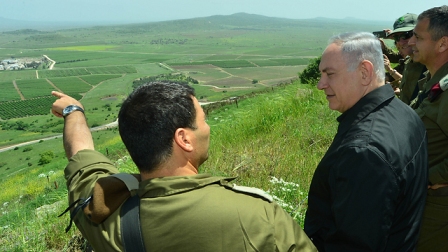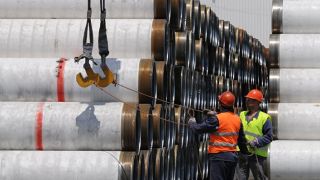Russia and Israel have a good chance to synchronize their watches. On Mar 9, they will hold top-level consultations in Moscow. It will be the fourth meeting of Vladimir Putin and Benjamin Netanyahu in just 1.5 years, but this time, Netanyahu made public the topic he was going to discuss.
Today, the situation all along Israel’s borders – especially, on the borders with Lebanon and Syria - is quite alarming. The Lebanese Hezbollah is active near the Golan Heights, with the Syrians sending more and more arms and military hardware to Beirut. The Israelis are trying to be one step ahead and are actively using their air forces on both sections.
But, as experts predicted, Israel’s concern must be the growing Iranian presence in the south and southwest of Syria. Until now, the Iranians have had no military base abroad. If they get one, they will gain the edge over their geopolitical opponents. The Israelis know this and are keeping a very close eye on the Iranians, especially in Syria.

Netanyahu’s speech before his visit to Moscow had a specific goal. He made it clear that from now on Iran’s and Hezbollah’s activities near his country’s borders will be a global problem. We expect him to come to Moscow with specific proofs of Iran’s plans to open a military base in Syria.
The last time he had such a detailed meeting with the Russians was before the latter’s counter-terrorist operation in Syria. Then Netanyahu also had facts in his hands – he was aware of the concentration of Russians troops in Latakia and was keen to know what that might mean. Now his concern is Iran. And he may well bring to Moscow lots of evidence from Mossad and Aman.
It seems that the Israelis know “what,” “where,” “how” and “when” the Iranians are “plotting” in Syria. The growing activity of Hezbollah may well be part of this plot. Until now, Hezbollah has been very careful and has abstained from active steps in Syria but now things have changed and Sheikh Hassan Nasrallah has begun to actively criticize the “Zionist regime” and to warn that his army has arms that can strike any point in the Israeli territory.
On Mar 2, Hezbollah published a video picturing nine strategic sites of Israel’s nuclear program. The message of that move was that the Lebanese Shias have arms to strike those sites. Earlier, Nasrallah warned the Israelis that his army was armed enough to ruin its nuclear reactor in Dimona and the ammonia tank in Haifa. But now Hezbollah has become much braver and may well provoke a direct military conflict.
Israeli and U.S. mass media have stirred up a real hysteria about Iran’s missile program. A few days ago, Fox News reported that on Mar 4-5 the Iranians launched two Fateh-110 short-range ballistic rockets. "It's a concern based on the range and that one of the missiles worked,” an anonymous Washington official told the news agency.
Despite the Israelis’ efforts to restrain Hezbollah’s rocket activity, the Lebanese are believed to have as many as 100,000-120,000 rockets in stock. Most of them are outdated short-range missile (1) but some are quite powerful, like extended precision Soviet Skad-Ds (2) and even more precise Iranian Fateh-100 (with a range of 250 km).
One of the Israelis’ key concerns is that the Lebanese may get Russian Yakhonts (P-800 Oniks, classified by NATO as SS-N-26), once given to the Syrians. This may chance the balance of forces in the regions. Former Head of the Israeli IDF’s Strategic Planning Division Michael Herzog was very sincere, when he said that Yakhonts in the hands of Hezbollah would become a “game changer” in the Israelis’ conflict with the Lebanese Shias (3).
One more enemy, Palestinian Hamas, has also become active now that it is led by Yahyo Sanvar (one of the leaders of the Izz ad-Din al-Qassam Brigades).
On the day, Hezbollah published the video, HAMAS said that it would revise its tactics on Israel and would start responding symmetrically – that is, if the Israelis strike their facility in Gaza, they will strike a site in Israel.
And it seems that HAMAS has necessary weapons for such counterstrikes. We mean not just Qassams but much more efficient rockets. HAMAS might have well obtained such weapons despite the Israelis’ blockade of Gaza. And if it has, this will be a big challenge for Israel’s Iron Dome.
Under such circumstances, the Israelis’ tactics may be “now or never.” The new U.S. зresident supports them, Iran’s Sunni neighbors see them as their partners against Tehran. What they lack is the Kremlin’s support. And what they want the Russians to do is not just to coordinate their activities in Syria but also to dissuade the Iranians from acting against Israel.
On Mar 5, Netanyahu told his ministers that he was going to Moscow to ask the Russians to restrain the Iranians. According to The Jerusalem Post, Netanyahu hopes that the Russians will understand him but for the Russians this situation is quite tricky as their pro-Israeli steps may be taken quite negatively in Iran.
It seems that the Iranians are ready to compete with the Israelis for the Russians’ preference. Their message is that long-term friendship with them is a better choice for the Russians than a situational alliance with the Israelis. And just a few hours before the publication of Netanyahu’s statement, they counteracted.
Iran fully supports the Russian aerospace operation in Syria and will render assistance to it further on, Iranian Defense Minister Hossein Dehghan told the Fars news agency on Mar 5. “We cooperate with Russia in supporting the legitimate Syrian authorities, whose official request gives ground for our countries’ presence in Syria. We utterly and completely support the actions of the Russian Aerospace Forces," Dehghan said.
He noted that the ground campaigns being conducted on the Syrian territory needed air support and present combat air force. “And for this purpose we render assistance to Russian aircraft, particularly at Shahid Nojeh Air Base (in the province of Hamadan) (4). This cooperation has been present for a limited period of time on the base of their request and our reply and will be continued if required,” Dehghan said.
So, we can see that the Iranians also have efficient intelligence and are also trying to be proactive – especially as the prize in this game is Russia’s support. So, let’s wait for the results of Netanyahu’s visit to Moscow.
(1) Most of the rockets – Katyusha-Arash-Grad – are unguided and have a range of 20-25 km. They can be launched both one by one and in a volley. The Iranian Fajr-1 has a range of 10 km.
(2) Syria supplied Hezbollah with North Korean Rodong-1 missiles (a copy of the Soviet-time Skad-D) in the spring-summer 2011, when the Syrian crisis was just starting.
(3) Michael Herzog, The Syrian Cauldron: A View from Israel // Fathom Journal, Autumn 2015.
(4) The first report about Russian planes deployed at the Iranian air base was received on Aug 16, 2016. On Aug 16-18, the Russians used that air base for attacking ISIL in Syria. The Russian Tu-22M3s and Su-34s left the facility when the Iranians expressed regret that its use by the Russians had been “misinterpreted.”
EADaily’s Middle East Bureau

 Kadyrov commented on the UAV strike on the Grozny City complex
Kadyrov commented on the UAV strike on the Grozny City complex Political grave: Zelensky rushes between two candidates for Yermak's chair
Political grave: Zelensky rushes between two candidates for Yermak's chair Born colonists are outraged: in India, Putin was "greeted like a God"
Born colonists are outraged: in India, Putin was "greeted like a God" The crown would not have fallen off Zelensky's head if he had stopped by to say hello — Sikorsky
The crown would not have fallen off Zelensky's head if he had stopped by to say hello — Sikorsky The world's first AI minister got caught on bribes
The world's first AI minister got caught on bribes The Austrian Foreign Ministry outlined the conditions for a "just" peace on Ukraine
The Austrian Foreign Ministry outlined the conditions for a "just" peace on Ukraine